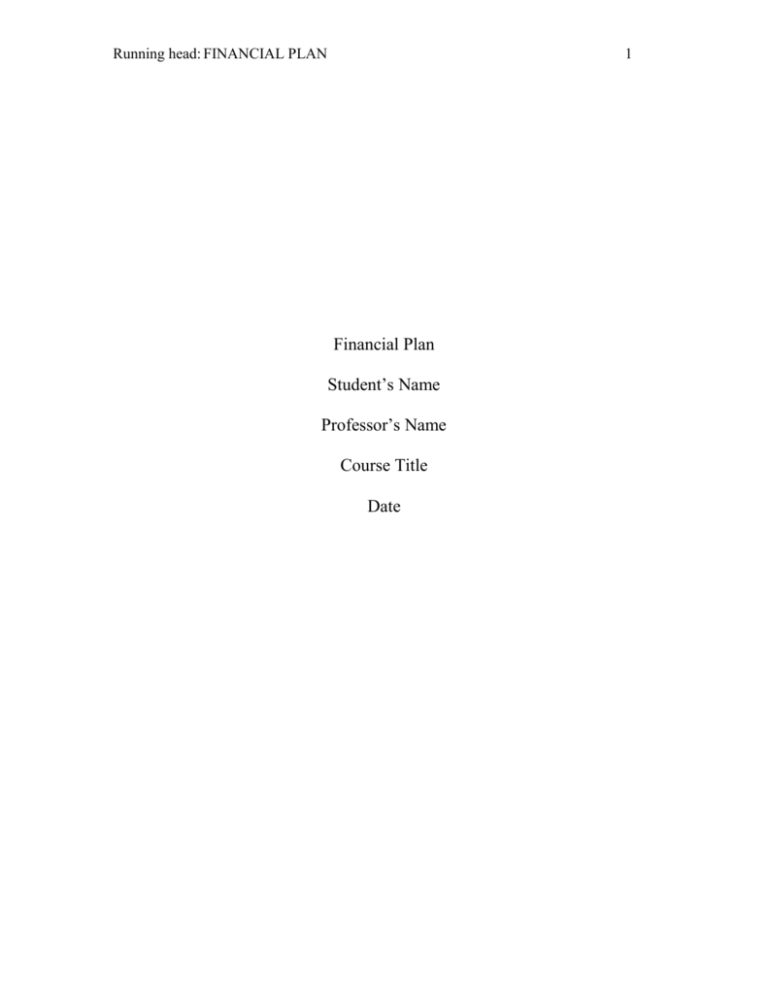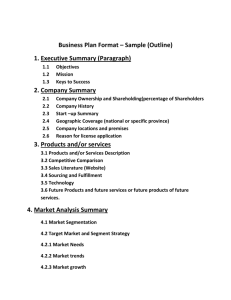Running head: FINANCIAL PLAN 1
advertisement

Running head: FINANCIAL PLAN 1 Financial Plan Student’s Name Professor’s Name Course Title Date 2 FINANCIAL PLAN Financial Plan According to Grable, J. E., et al. (2008), both the financial plan and the projected budgets help an organization to be successful both in the present and in the future operations. Even though the two aspects go hand-in-hand, they are different in how they influence organizational financial success. The main differences include the fact that the budgets helps one the map out the key expenses that will be incurred in weeks or months to come while financial plan helps on to plan for funding financial objectives and goals in 5 years and over. Creating a financial plan means make a long-term strategy for achieving goals while making budget implies the management of money in day-to-day business operations. In a financial plan, one track records of progress in quarterly and semi-annually basis which in a budget, expenses and incomes are tracked in a weekly and monthly basis. Fiscal details In a financial plan, there are fiscal details that are included. Stovall, J., & Maurer, T. (2011) stated that these fiscal details indicate the flow of government expenditures, the organizational debts and the sources of revenues. There are government expenditures that will get into the organizations and private business in form of subsidies and other incentives to the organization. This portion of the fiscal details is included in the financial plan. The debts that the organization incurs through both external and internal borrowing and also the used other means of financing its operations are also included in the financial plan. It also includes the tax liability of the company to the tax authority. Finally, another important financial detail is revenues that are collected from business operations. These revenues are in form of sales returns and also profits that can be ploughed back to the 3 FINANCIAL PLAN business and others are paid to the employees and shareholders in common and preferred stocks. The assumptions use in the projected budget In developing a projected budget, there are various assumptions that hold in a order to develop a successful projected budget that will enable the organization to manage it expenses and income in a fiscal year or within any other given period of time. It is assumed that the increase in revenue, salaries and supply expenses per year are 20%, 10% and 5 % respectively. It’s also assumed that travel, maintenance, contracts, marketing, miscellaneous and salaries as a percentage of revenue are 1, 1, 4, 0.5, 2 and 75% respectively. Other assumptions that will be important in making a projected budget include the following: 1. The real gross domestic product (GDP) growth rate for the projected period is 1.6% to 3.6% for 2015 and the trend rate for 2016 to 2018 is 4.5%. 2. The investment return is estimated to be 4.5% in 2015 and will be in the range of 3.7% to 6.2% per year thereafter. 3. The Land premium is estimated to be 2.5% of GDP for 2015-16 onwards. 4. The fiscal reserves balance as at 31 June 2018 previously estimated at $770.4 billion is now revised to $990.9 billion, representing about 30.9% of GDP for that year. By 31 June 2019, the estimated fiscal reserves balance is estimated at $850.3 billion, representing 31.3% of GDP for that year. Other assumptions include: gift revenues, the salary pool, overhead rates on sponsored projects, the benefit rate, endowment distribution and capital requirement. 4 FINANCIAL PLAN The elements of a projected budget Swedroe, L. E., (2010) argued that there are elements that are included in a projected budget that makes it a completed product that will positively influence the financial decision making of an organization. By definition, budget elements are resources such as capital, people and materials or any other thing that is required to complete a project, program or a task planned to be undertaken. These elements can be categorized into two sections which are the direct costs and F&A costs. The direct costs are the cost that can be identified easily with a specific project. These direct costs are associated with the following: 1. Salaries and wages. The monthly or annual payments of all the employers or those who are going to work on the projected are to be named and the overall total cost of payments in form of salaries to be indicated. 2. Employee benefits. The composite employee benefit rates should be compiled for every category of employee in the organization. The projected budget should indicate whether the rates reflects the historical rates or are based on the published composites for every individual employee. 3. Consultants. The names of all the consultants in different fields should be indicated. Each pay rate by day and the period in which each will be paid must be indicated. 4. Equipment. All items that are purchased for a specific project or tasks should be indicated along with the initial purchase costs, the projected cost of maintenance and other associated activities to improve their performance. 5 FINANCIAL PLAN 5. Supplies. This is the major category of allowable expenses which include: chemicals and survey forms. That estimated cost of every item type is indicated. 6. Travel costs. The information that should be known on this include, the purpose and destination of every trip, the number of people who go to each trip, the mode and cost of transportation and the rate and number of days per diem. 7. Patient medical care cost. Information that will be included in this element of a projected budget include: information on the outpatients and inpatients, the hospitals that provide care and the cost of providing health care services. 8. Renovations and Alternations. The processes necessary to install a new equipment or covert an interior space necessary to adapt an existing facility should be itemized and justified. For example, this include: contractual costs. The other direct costs include the following: publication costs, subject fees, alterations and renovations, computer usage rates, allowable telecommunication charges, postage and allowable telephone etc. The F&A costs are also referred to as overhead cost or the facilities and administrative charges. These are costs that are incurred for joint or common objectives. The F&A costs in a projected budget includes the following: library expenses, space, payroll, utilities, building depreciation and accounting The capital expenditure planning and contingency plans for unexpected events Booker, J., et al. (2006) stated that the capital expenditure planning and contingency plans for unexpected events should be included in the financial plan for the organization. 6 FINANCIAL PLAN Capital expenditures are heavy investments that are made by the public officials that help to keep the economy in progress such as investing in long-term initiatives. Capital expenditure planning therefore involves process of utilizing the procedures and methodologies that a company uses in reviewing its operating needs and also evaluates its long-term business requirements. On the other hand, a contingency plan is part of the risk management plan which helps to prepare the organization to respond to unplanned and unexpected events. A contingency plan is normally used as an alternative action plan if the expected results fail to materialize. It is also a component of disaster recovery and business continuity apart from risk management. Both capital expenditure planning and contingency plan are implemented in a financial plan and budgets so as to acts buffers in case of the occurrence of unexpected events. Budget summary The current business model of the organization is the Direct Sales model where direct selling the primary route to market. Emergence of internet as been used as a distribution channel and thus enabling the organization to avoid middlemen and sell direct to final consumers of products. We rarely go against the way the organization planned its finances in the past. We only make changes in the accounting methods when necessary or advised depending on the kind of financial information that is present in a given period. Effects of internal resources and financial capabilities on the financial plan Organization’s internal resources and financial capabilities positively affected the financial plan. LLP, E. Y., et al. (2004), argued that these resources and financial FINANCIAL PLAN 7 capabilities forms the internals sources of finances to fund the future plans of the organization and other internal resources may be converted as finances to boost future plans of the organization. The internal resources and financial capabilities also affect the implementation of the financial plan due to the internal rigidities that are found in most organizations and thus may delay the implementation of a financial plan. 8 FINANCIAL PLAN References Booker, J., CCH Canadian Limited., & Financial Advisors Association of Canada. (2006). Financial planning fundamentals. Toronto: CCH Canadian Limited. LLP, E. Y., Nissenbaum, M., & Raasch, B. J. (2004). Ernst & Young's Personal Financial Planning Guide. Hoboken: John Wiley & Sons. Grable, J. E., Klock, D. D., & Lytton, R. H. (2008). The case approach to financial planning: Writing a financial plan. Cincinnati, Ohio: National Underwriter Co. Stovall, J., & Maurer, T. (2011). The ultimate financial plan: Balancing your money and life. Hoboken, N.J: Wiley. Swedroe, L. E., Grogan, K., & Lim, T. (2010). Active versus Passive Management. Hoboken: John Wiley & Sons.





